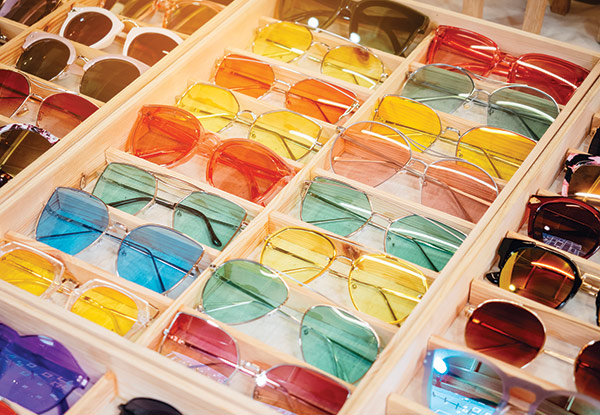
By Preston Fassel
In an article last year, I talked about the efficiency of yellow-tinted glasses as an inexpensive and easy second pair sale. Yellow lenses are efficient HEV blockers and can also be used in a variety of other situations, from low-light sporting activities to shooting (if the lenses are impact resistant and in an appropriate frame), making them an ideal way to get your patient walking out the door with more than one pair in his or her hands and more dollar signs in your bank account. Win-win. However, during a recent trip to my favorite dispensary, I noticed something about their frame board that got me thinking about other color options as well.
“Tints are coming back in a big way,” says Javier Tellez, head optician at Glass Optical in Dallas, Texas. Although the majority of the frames on display there have standard demo lenses, several of them have tinted plano lenses edged into them to entice patients with the idea of sunwear and second pairs. As Tellez points out, for patients wanting to diversify their wardrobes, a tinted CR-39 or tintable poly lens is comparatively cheap. Glass does all their tinting and edging in-house, allowing them to not only pass along savings to the patient but to work with them on customizing tints to their own purposes. Indeed, while older wearers might tend to stick with traditional grays, browns and G-15s, Millennials are just as likely to opt for sunwear as they are for “cafe shades.” These are generally a #1.5 to #2 tint in unconventional colors such as blue or purple, made to be worn indoors or in low-lighted social situations, meant more for aesthetics than for some practical function.
For older opticians, the concept isn’t new—these are the successors to those dozens of blue gradient aviators you sold in the 1970s and early ’80s. For newer opticians, it’s an objective lesson in adjusting your business model to meet the market’s demands. I recently heard an optician in his early 40s lamenting the trend, criticizing Millennials for their “vapid” eyewear choices. If they’re willing to pay for it though, and it isn’t damaging their eyes, I say who cares? If a patient wants to plunk down dollars for a pair of, say, red #2 gradient John Lennon glasses, why not help them pick out the frames and happily take the money as they happily walk out the door? (I bring up that specific combination because I saw someone wearing it lately—and some accommodating optician profited accordingly). With an in-house tint machine, the possibilities are limitless. Pair tinted poly lenses with an inexpensive frame, and you’ve got yourself a winner for cash-pay patients or as a second pair bargain for those with insurance. It’s an easy way to stand out to your younger patients and to open up your older patients to a wider range of possibilities in looking younger and feeling better about themselves.
Stay tuned for future installments of “Color My World,” in which I’ll look at the benefits and drawbacks of various unconventional tints and the ways in which you can market them to your patients.













